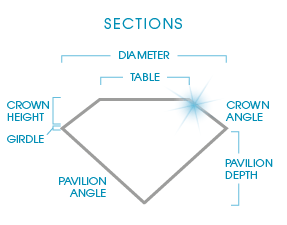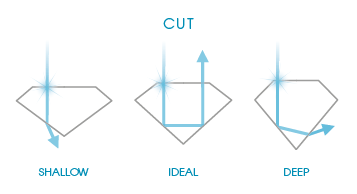A diamond is often the main feature of a ring, and will be the focus when people first look at it. Getting educated about the 4Cs will help you to understand the reason why the diamond is more valued than other gemstones. Diamonds are graded using a universal system that judges the stones on its colour, clarity, cut and carat-weight, known as the 4Cs’. Each diamond, regardless of its size, has a set of unique characteristics that determine its value.

Cut
The cut is considered to be one of the most important characteristics of a diamond. The cut of a diamond determines its brilliance. A poorly cut diamond will have a dull appearance even if it has perfect colour and clarity.
The cut should reflect the maximum amount of light to the viewer’s eye. If a diamond is cut too shallow, for instance, light will be lost out of the pavilion (bottom) and the diamond will lose brilliance. If the diamond is cut too deep, the light will escape through the sides and the diamond will appear dark.

Different Gemmological laboratories use different scale charts to evaluate the cut of the diamond. For example GIA uses the following scale : Excellent – Very Good – Fair – Poor.
We always recommend choosing a diamond with a minimum “Very Good” grade.
Colour
Diamonds come in a variety of colours. Colour refers to the presence of a yellow or brown tint in diamonds. Diamond colour grading is done in alphabetical order, on a scale of D to Z.
D is colourless and Z light yellow.

D Colour diamonds are completely colourless. Because they are very rare, hence the high price it commands.
E – F colour diamonds are considered colourless as well, however they contain an indication of colour that a gemmologist can detect.
G – H colour diamonds are Near colourless. To the naked eye they appear colourless, although they do contain very small traces of colour.
I – J colour diamonds are Near colourless with a faint trace of yellow not easily identified by the naked eye.
K – M colour diamonds have Faint yellow tint, visible to the naked eye.
N – Z: colour diamonds have Very light yellow tint, easily identified by the naked eye.
At Raffini Jewellers, we recommend buying a diamond no lower than the “Near colourless” grade, as it tends to show a tint of yellow colour, more visible especially in a white gold or platinum setting.
Clarity
Clarity in a diamond refers to the measure of its purity. A diamond’s clarity rating is determined by the number, size, type and location of inclusions under 10 X magnification. Clarity characteristics contribute directly in making every diamond completely unique.

FL and IF Diamonds are very scarce, to the extent that only less than 3% of jewellery quality diamonds are rated IF. Inclusions are not visible to the naked eye in The VVS1, VVS2, VS1 and VS2 grade diamonds. SI1 is the lowest grade with flaws often invisible to the naked eye. SI2 inclusions are usually visible to the naked eye, The I1, I2, and I3 diamonds have inclusions that are almost always visible to the naked eye.
We do recommend when deciding on a diamond, not to go lower than the SI2 grade. We do believe that diamonds should be within the reach of everyone’s budget, therefore an SI1 or an SI2 is an alternative way of owning your dream diamond without any noticeable inclusions to the naked eye.
Carat
As with all precious stones, diamond weight is conveyed in carats. The word carat originated from a natural unit of weight; the seeds of a carob tree.
In earlier times, Diamonds were traditionally weighed against these seeds until the system was standardized and one carat was fixed at 0.2 grams (one fifth of a gram.) One carat is divided into 100 points, so that a diamond of 50 points is described as a half of a carat, or 0.5 points. The value per carat increases with carat size, as the larger diamonds are harder to find. For example, 2 one-carat diamonds will not cost as much as a single two-carat diamond, as the 2 carat diamond is rarer. It is very important not to mistake carat weight as referring to the dimensions of a diamond. It refers to weight only. Weight can hide in different parts of the stone particularly if it is poorly cut.

Which Carat Weight Is Right For You?
This question has no direct answer. The size of a diamond has the biggest impact on its price. The carat that is right for you really depends on your budget. Although weight clearly does matter because it affects the price greatly, you should consider taking into consideration the diamond’s Cut, Colour and Clarity.